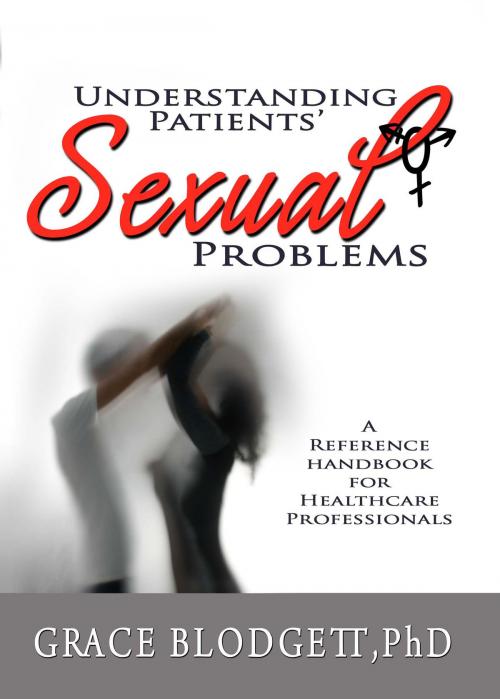Understanding Patients' Sexual Problems
A Reference Handbook for Healthcare Professionals
Nonfiction, Health & Well Being, Health| Author: | Grace Blodgett | ISBN: | 9781483557885 |
| Publisher: | BookBaby | Publication: | August 17, 2015 |
| Imprint: | Language: | English |
| Author: | Grace Blodgett |
| ISBN: | 9781483557885 |
| Publisher: | BookBaby |
| Publication: | August 17, 2015 |
| Imprint: | |
| Language: | English |
For many, a person’s sexuality remains a very private issue, and when people are not familiar with sexual terms or have no experience with sexual practices that are different from their own, awkward situations occur. Imagine how uncomfortable it may be for healthcare professionals (HCPs) to discuss sexuality with their patients or support the diverse sexual needs of patients whose behaviors they do not understand or accept. HCPs tend to avoid the patients’ sexual concerns, and while avoidance is not a malicious or conscious act, it happens as a result of their own sexual insecurities and lack of sexual knowledge, time, and confidence in their counseling skills. Consequently, I felt compelled to write this sexuality handbook, Understanding Patients’ Sexual Problems, so HCPs might gain a greater understanding of the patients’ sexual needs, concerns, and anxieties. I am an RN of fifty years, experienced at most levels of nursing practice (including 20 years in sexology), with a master’s degree in nursing and a Ph.D. in Human Sexuality, consequently I believe I am qualified. Chapter 1 presents the environment in healthcare arenas, and the many obstacles and barriers that some HCPs face as a result of their own and the sexual issues of others. Many misconceptions and misperceptions lead to harmful miscommunications. This chapter describes the professional power levels that exist; however, things are changing for the better. As the regimented, hierarchical atmosphere changes, the various disciplines work toward more teamwork and acceptance of the beliefs, practices, and mores of others. Chapter 2 describes the sexual behaviors and social factors that influence sexuality in American society, to include sexual attraction, orientation, associated behaviors and lifestyles. Chapter 3 identifies the proclivities of American adults, societal mores, and the mass media’s impact on sexual behavior. Sexual dreams/fantasy, flirting, masturbation, pornography, prostitution, sexual scripting, among others; all part of the many sexual activities in America today. The sexual issues of childhood and adolescence are identified in Chapters 4 and 5, with an emphasis in 5 on high risk sexual behaviors of teens. Chapter 6-11 provides easy, rapid access to 85 sexual behaviors/concerns and provides facts, attitudes and behaviors associated with those sexual issues. They are described in detail in an outline format which provides a similar pattern for information and topic location. Each topic outline contains a definition, signs/symptoms, origins, background, therapeutic and supported interventions, and potential outcomes. This format facilitates comprehension, understanding, problem interventions and discussion of the possibilities for treatment: to better understand the patient’s situation. Prejudice in the healthcare arena runs rampant, and HCPs must face their own prejudices and those of others that exist as a result of the patients’ engagement in perceived behaviors. However, lawful sexual behaviors by those who are gay, lesbian, bisexual, transgender or transsexual often receive prejudicial treatment. Prejudice also extends to the elderly, especially with illness--many people assume that senior citizens are asexual; not so. However, erectile dysfunction, cancer, diabetes, multiple sclerosis, and Alzheimer’s disease are translated to mean asexual. We are all sexual beings with sexual thoughts and feelings, and to deny or ignore that fact is simply inhumane; it is just that the vigor and passion of the flame fluctuates. This information will provide for more comfortable discussions between patients and HCPs, and in the process it will allow patients to heal better, physically and emotionally, which, after all, is the ultimate goal of the healthcare profession. I ask healthcare providers and lay people to identify and examine their own sexual inhibitions, misconceptions, and insecurities; the results might well be enlightening.
For many, a person’s sexuality remains a very private issue, and when people are not familiar with sexual terms or have no experience with sexual practices that are different from their own, awkward situations occur. Imagine how uncomfortable it may be for healthcare professionals (HCPs) to discuss sexuality with their patients or support the diverse sexual needs of patients whose behaviors they do not understand or accept. HCPs tend to avoid the patients’ sexual concerns, and while avoidance is not a malicious or conscious act, it happens as a result of their own sexual insecurities and lack of sexual knowledge, time, and confidence in their counseling skills. Consequently, I felt compelled to write this sexuality handbook, Understanding Patients’ Sexual Problems, so HCPs might gain a greater understanding of the patients’ sexual needs, concerns, and anxieties. I am an RN of fifty years, experienced at most levels of nursing practice (including 20 years in sexology), with a master’s degree in nursing and a Ph.D. in Human Sexuality, consequently I believe I am qualified. Chapter 1 presents the environment in healthcare arenas, and the many obstacles and barriers that some HCPs face as a result of their own and the sexual issues of others. Many misconceptions and misperceptions lead to harmful miscommunications. This chapter describes the professional power levels that exist; however, things are changing for the better. As the regimented, hierarchical atmosphere changes, the various disciplines work toward more teamwork and acceptance of the beliefs, practices, and mores of others. Chapter 2 describes the sexual behaviors and social factors that influence sexuality in American society, to include sexual attraction, orientation, associated behaviors and lifestyles. Chapter 3 identifies the proclivities of American adults, societal mores, and the mass media’s impact on sexual behavior. Sexual dreams/fantasy, flirting, masturbation, pornography, prostitution, sexual scripting, among others; all part of the many sexual activities in America today. The sexual issues of childhood and adolescence are identified in Chapters 4 and 5, with an emphasis in 5 on high risk sexual behaviors of teens. Chapter 6-11 provides easy, rapid access to 85 sexual behaviors/concerns and provides facts, attitudes and behaviors associated with those sexual issues. They are described in detail in an outline format which provides a similar pattern for information and topic location. Each topic outline contains a definition, signs/symptoms, origins, background, therapeutic and supported interventions, and potential outcomes. This format facilitates comprehension, understanding, problem interventions and discussion of the possibilities for treatment: to better understand the patient’s situation. Prejudice in the healthcare arena runs rampant, and HCPs must face their own prejudices and those of others that exist as a result of the patients’ engagement in perceived behaviors. However, lawful sexual behaviors by those who are gay, lesbian, bisexual, transgender or transsexual often receive prejudicial treatment. Prejudice also extends to the elderly, especially with illness--many people assume that senior citizens are asexual; not so. However, erectile dysfunction, cancer, diabetes, multiple sclerosis, and Alzheimer’s disease are translated to mean asexual. We are all sexual beings with sexual thoughts and feelings, and to deny or ignore that fact is simply inhumane; it is just that the vigor and passion of the flame fluctuates. This information will provide for more comfortable discussions between patients and HCPs, and in the process it will allow patients to heal better, physically and emotionally, which, after all, is the ultimate goal of the healthcare profession. I ask healthcare providers and lay people to identify and examine their own sexual inhibitions, misconceptions, and insecurities; the results might well be enlightening.















